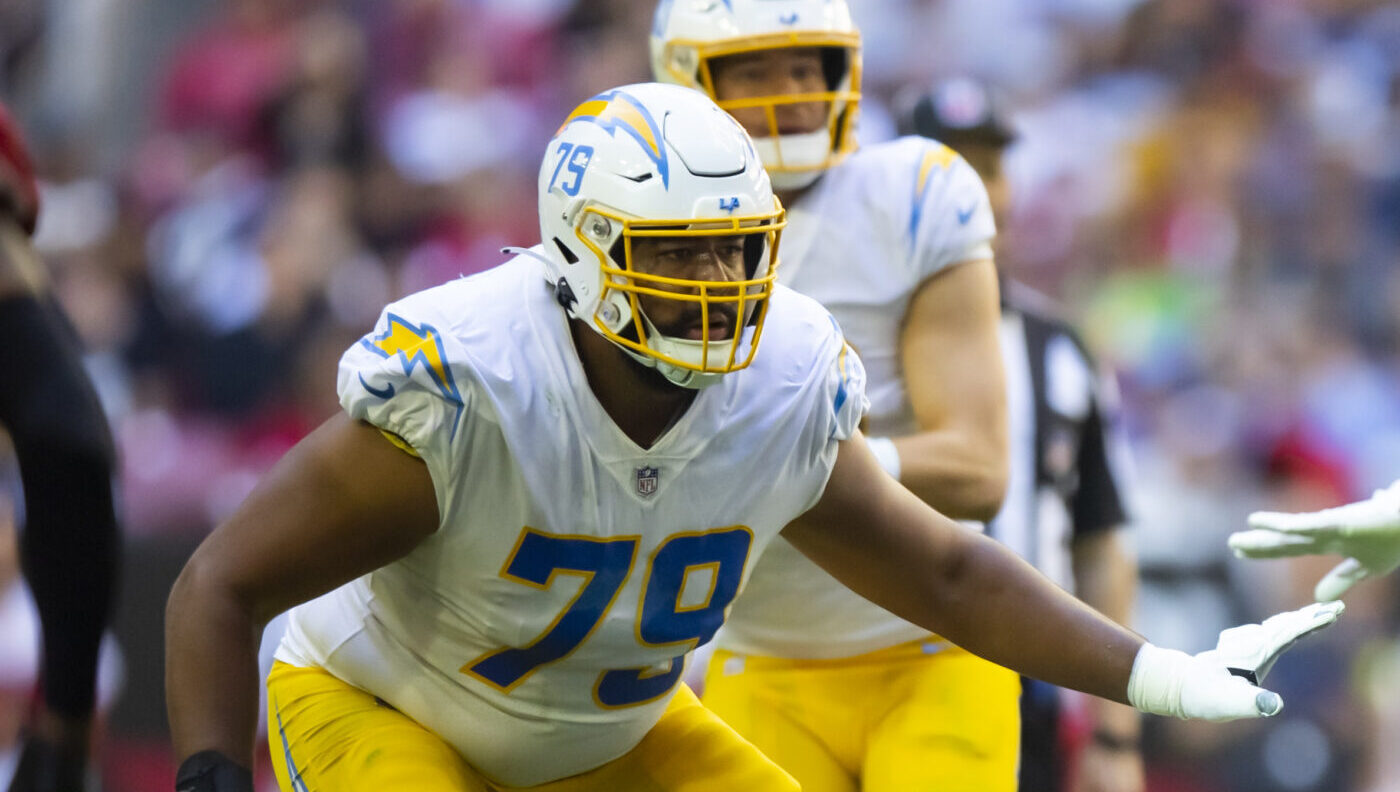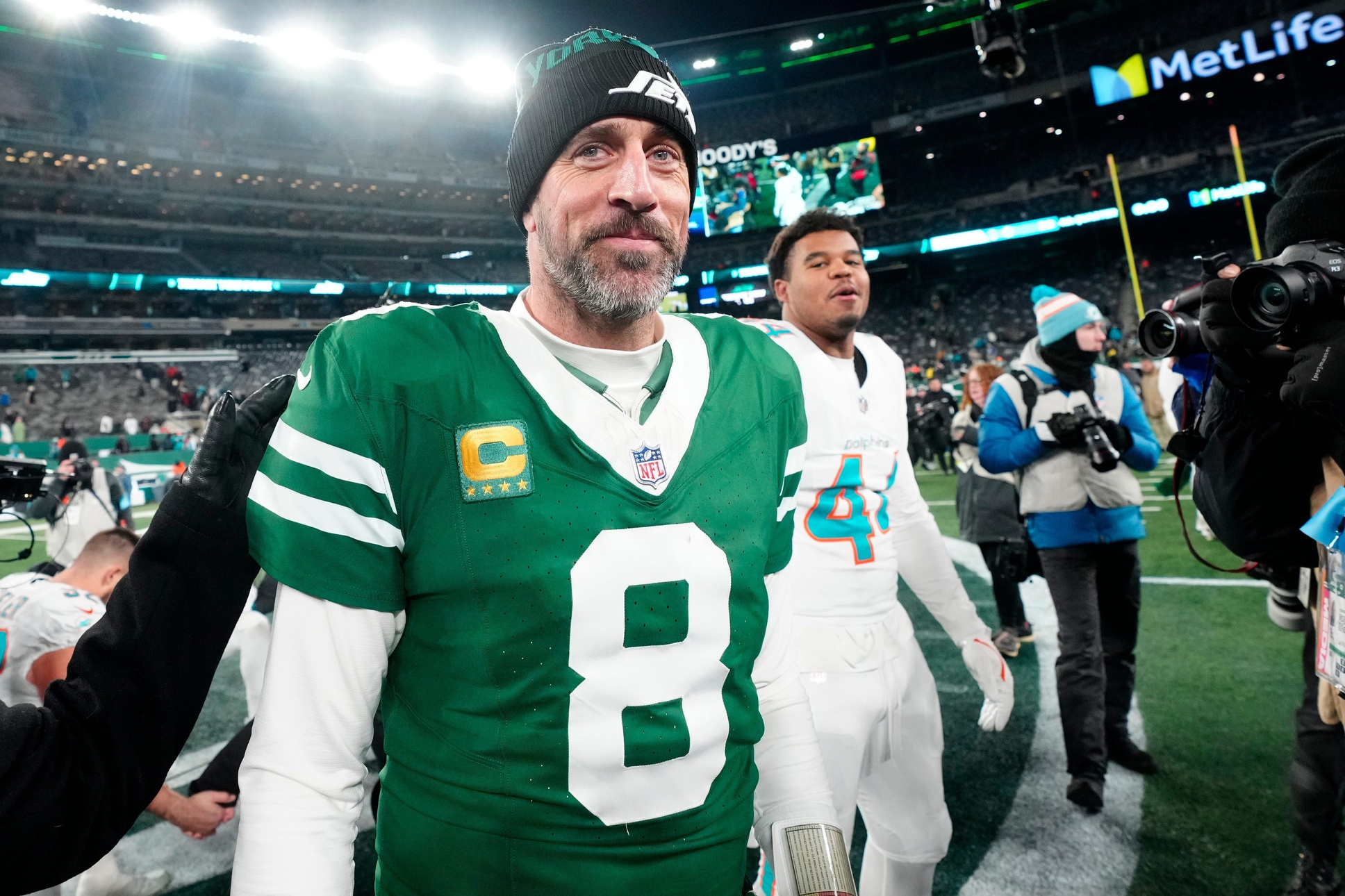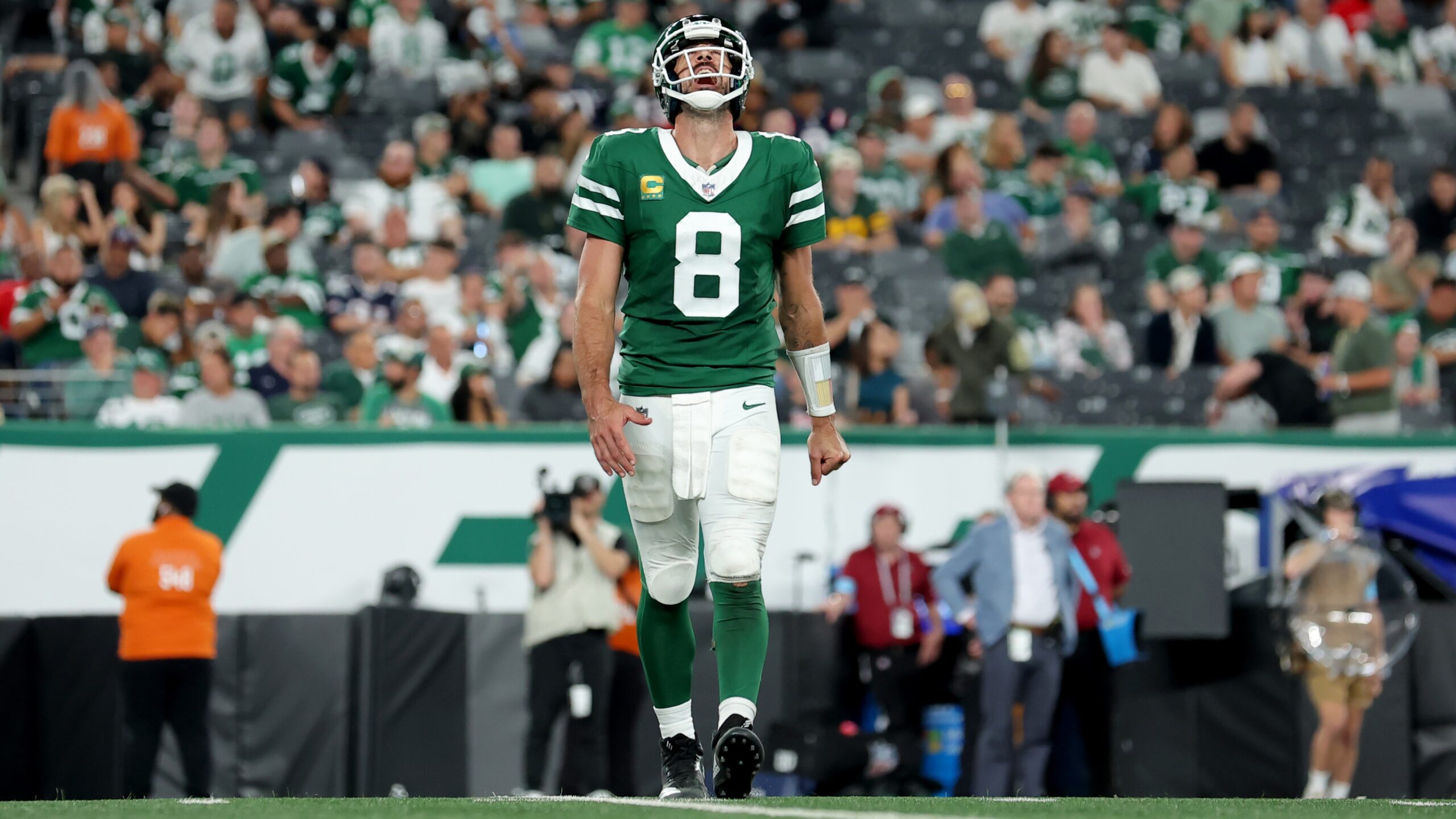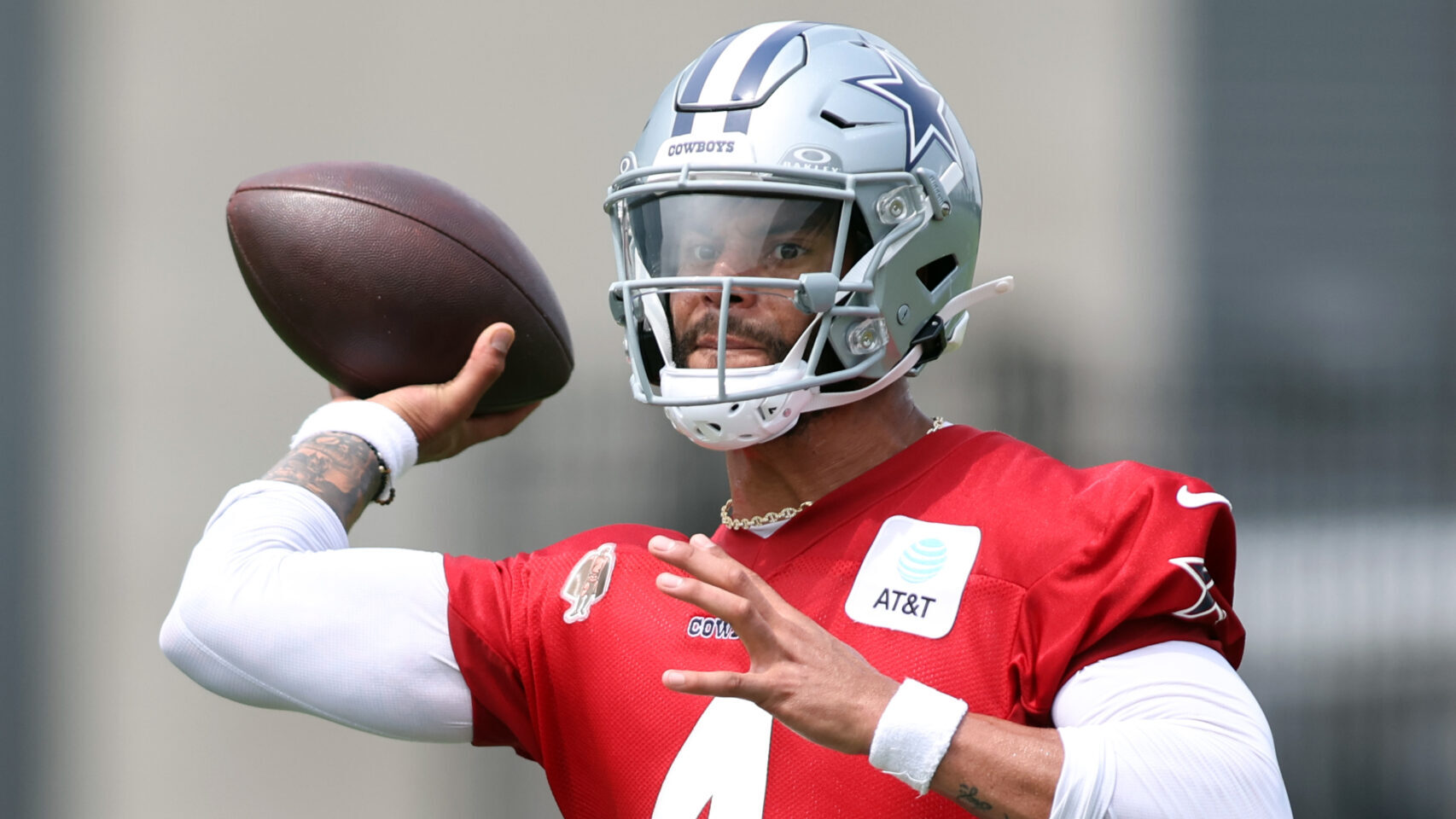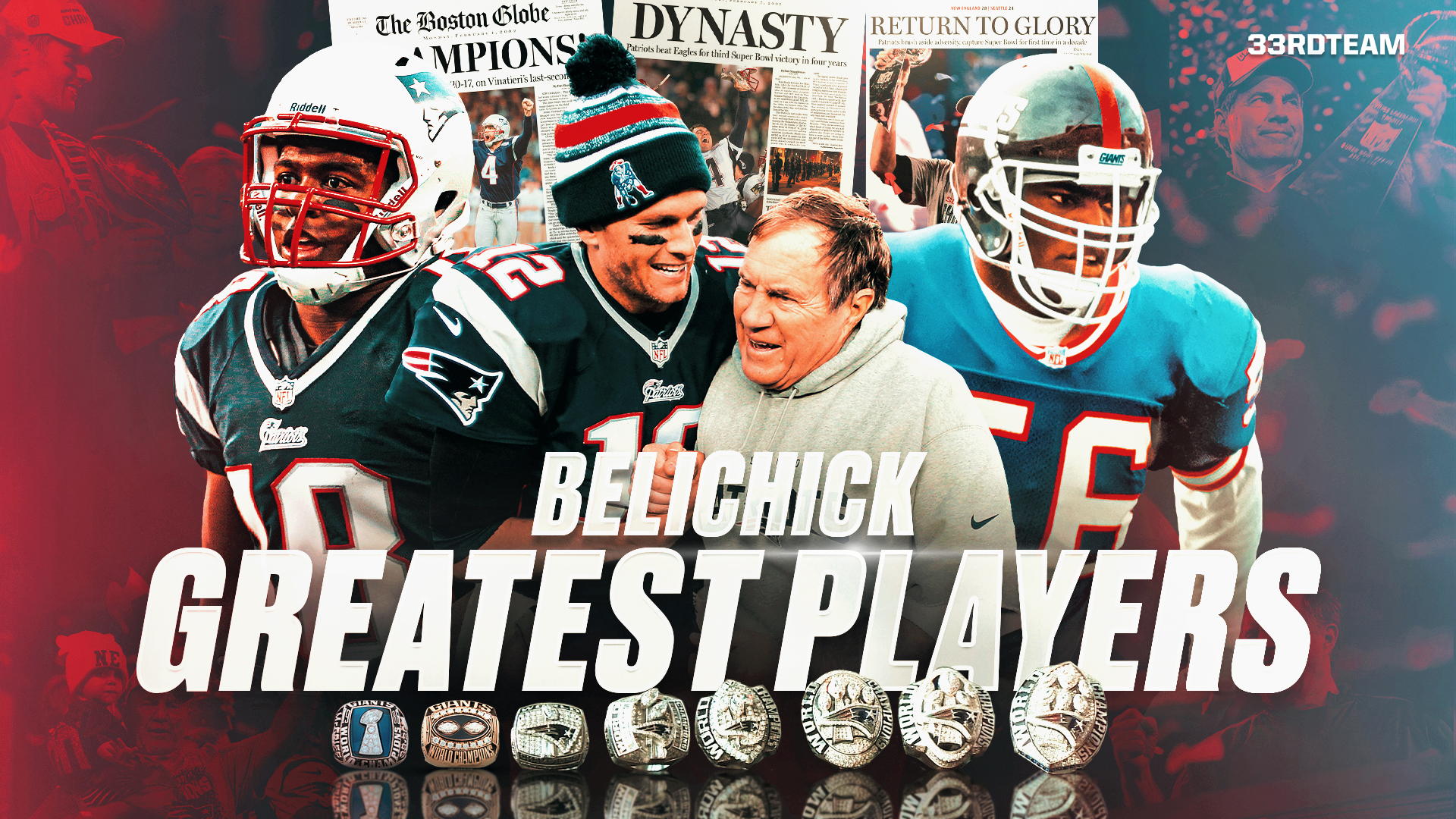Analysis
6/27/23
44 min read
Every NFL Team's Biggest X-Factor Entering 2023 Season
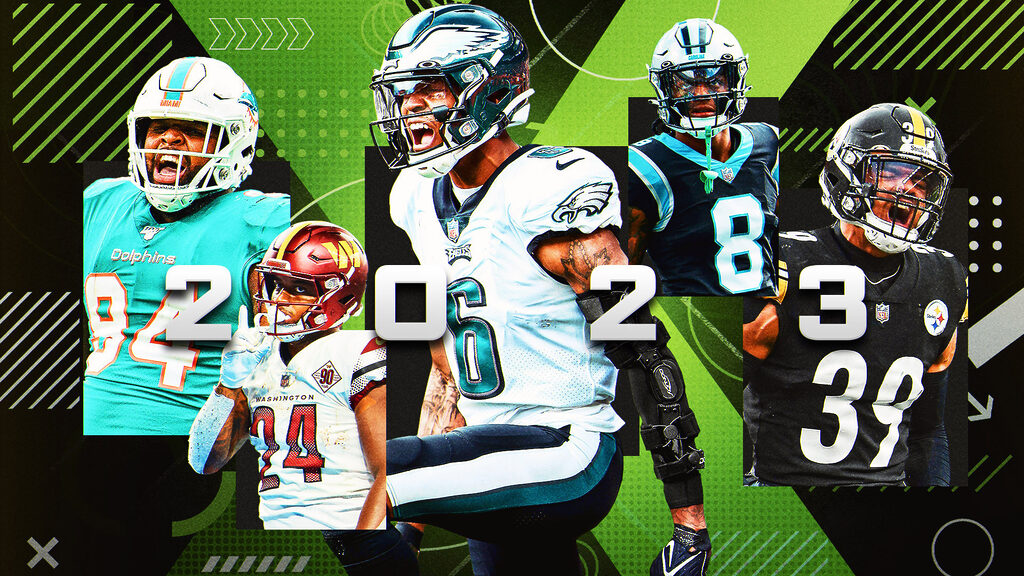
There are plenty of things that can help you see what will help an NFL team have success. Then there are things that are more of an unknown, often referred to as an X-factor. Those X-factors can have a huge impact in a league where the separation between teams is thin.
Since they're so important, we've decided the list one for every team.
Each Team's Biggest X-Factor
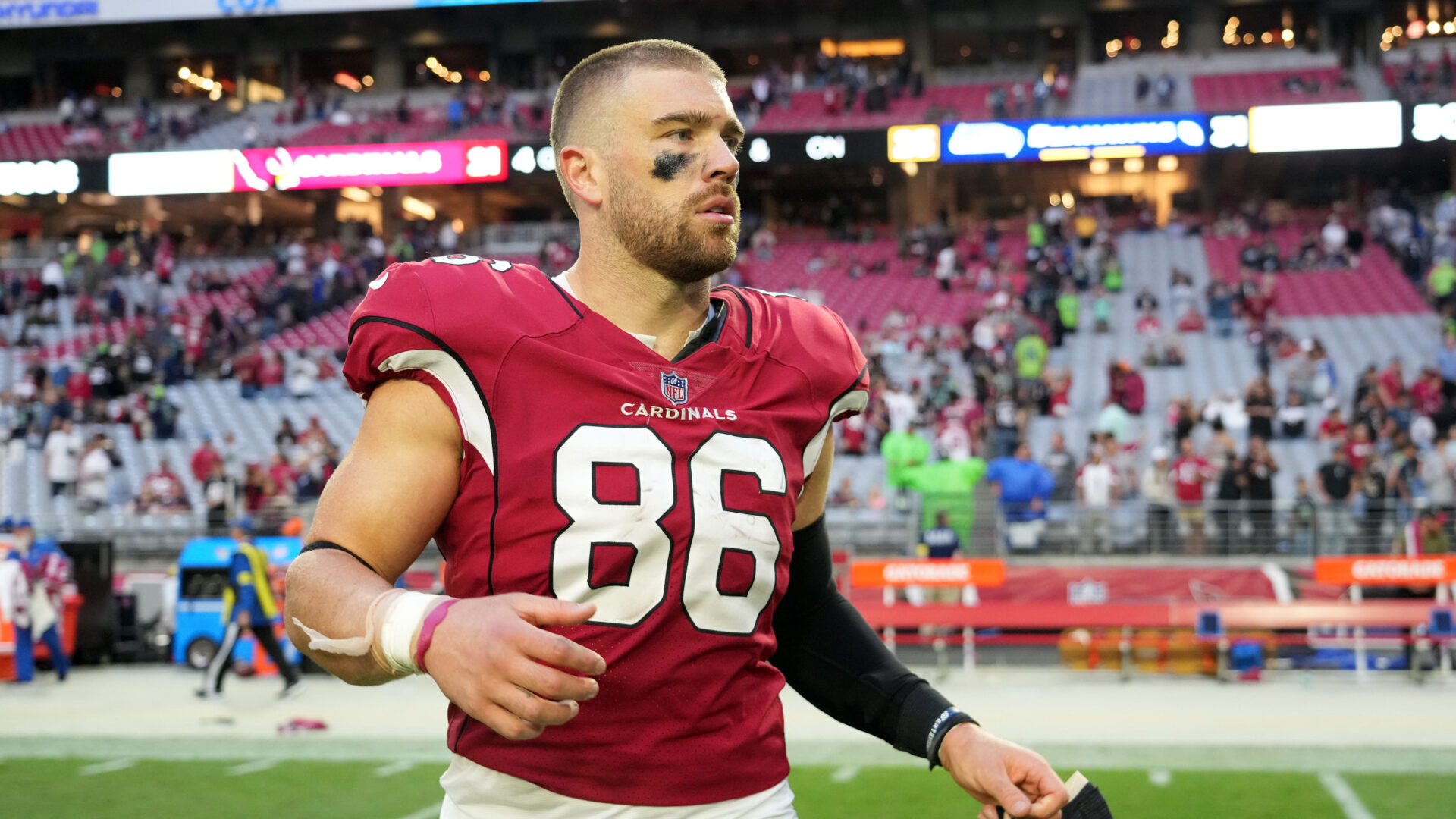
 Arizona Cardinals
Arizona Cardinals
TE Zach Ertz
It would make sense for first-time offensive coordinator Drew Petzing to run a version of the system he worked in as the Cleveland Browns quarterback coach under Kevin Stefanski. Though middle-of-the-pack in total play-action frequency, the Browns, in the Baker Mayfield years, were top-five in bootlegs and rollout usage. Those moving pocket tactics, besides building veritable fakes off their wide zone run game foundation, were a great approach to take with a shorter quarterback like Mayfield.
Even with Kyler Murray’s ACL recovery likely to eat well into the season, Petzing is undoubtedly building his offense around the 5-foot-10 quarterback. There is no question Murray is hindered by his lack of height. It shows in his decision-making and unrefined pocket movement. For a play-caller, designed pocket movement is mandatory, not just for hiding Murray’s weaknesses but also accentuating his strong mobility and athletic instincts.
Most bootleg designs have three receivers flood one side of the field. One goes deep, intermediate and shallow. It’s a great way to attack the zone defenses frequently played on first and second down. The majority of these throws go to the intermediate receiver – especially in a system that often gets to floods via crossing routes, which Petzing’s will.
The throws that don’t go deep usually go shallow. Tight ends Zach Ertz and Trey McBride will almost always be operating at one of those two levels. Ertz has been a quality intermediate route runner for many years. McBride teased deceptive athleticism and made a handful of plays on flood variations as a second-round rookie last season.
 Atlanta Falcons
Atlanta Falcons
CBs A.J. Terrell and Jeff Okudah
One of the great mysteries entering 2023 is what kind of scheme will first-time defensive coordinator Ryan Nielsen run. Nielsen entered the NFL as New Orleans’s defensive line coach in 2017 and became a steadily ascending star. He was responsible for much of the run defense and called the stunts and twists in some of the Saints’ third-down packages.
But a defensive coordinator’s identity is most associated with the coverages he calls, and that’s where the mystery comes in. Nielsen has been exposed to a lot of coverages; the Saints have long had one of the NFL’s most schematically diverse pass defenses, steadily shuffling through the spectrum of foundational coverages: Cover 1, 2, 3, 4, 6 and 8. Last season, in pass situations, they ranked 17th in zone coverage usage and 16th in man.
The Atlanta Falcons, under defensive coordinator Dean Pees the last few years, laid their foundation on creatively disguised zone coverage. Typically, that’s a great way to hide your corners. But that’s where it gets interesting. A.J. Terrell is a true No. 1 corner. He is agile and technical enough to travel with most No. 1 receivers. And now, opposite him is Jeff Okudah. His career in Detroit did not pan out as hoped, but no corner becomes a No. 3 overall draft pick without having the raw talent to thrive in man-to-man.
There were moments in Detroit where Okudah delivered on his promising potential – they were, unfortunately, just interspersed in too many peaks and valleys. But the bottom line: Okudah is a worthwhile flyer with a potentially high upside.
Nielsen and defensive backs coach Steve Jackson will trust Terrell. If they can also trust Okudah, they’ll be confident calling for solo man coverage outside, opening possibilities for schematic aggression and disguise up front and inside.
Nielsen can coach the fundamentals. And his pass rush group of Grady Jarrett, Calais Campbell, Lorenzo Carter and Bud Dupree, while certainly not terrifying, is probably just good enough to be leaned upon. If Nielsen wants to sit back in sound zone coverages and just rush four, he can.
But personality-wise, the guess here (and it’s just a guess) is he’d like to be attack-minded with various stunts, twists and gap-exchange pressures. He can experiment there if he trusts his corners outside.
 Baltimore Ravens
Baltimore Ravens
Edges Odafe Oweh and David Ojabo
There is no bigger schematic change in 2023 than the Baltimore Ravens replacing the uber-crafty, 2-back/2-tight end-driven run-heavy Greg Roman offense with what presumably will be a more modernly traditional three-receiver, pass-driven Todd Monken offense. This transformation is too radical and unsubtle to qualify as an X-factor.
On the other side of the ball, much more quietly, this team has already undergone another schematic shift. After leading the league with a 62 percent third down blitz rate under defensive coordinator Wink Martindale from 2018-2021, the Ravens in 2022, under first-time defensive coordinator Mike Macdonald rushed five-or-more players on just 42 percent of third downs (seventh most in the league). It was still an aggressive approach, and MacDonald, like Martindale, can be creative with designer pressure. But unlike Martindale, Macdonald does not live and die with the blitz.
So it reasons MacDonald relies more on his men up front to generate pressure on their own. This means a lot rides on the young edge rushers 2021 first-rounder Odafe Oweh and 2022 second-rounder David Ojabo. This becomes especially true when considering the Ravens are thinner at cornerback than they’ve been in years.
MacDonald’s use of two-deep coverages seems likely to rise (last year on third downs he played two-deep coverage 40 percent — almost exactly the league average). Oweh did not stand out much in 2022. Ojabo missed the season after tearing his Achilles at Michigan’s pro day. Both men must be noisy for MacDonald to play the way he presumably wants (and maybe has) to play.
 Buffalo Bills
Buffalo Bills
C Mitch Morse
The evidence suggests the Buffalo Bills are committing more to the ground game after ranking 24th in running back carries per game in 2022. They drafted Dalton Kincaid in Round 1. Yes, he’s much more of a receiving tight end, but with Dawson Knox already aboard, the Kincaid addition suggests a looming uptick in two tight end sets – something Buffalo used less (6.3 percent of snaps) than every team except Las Vegas (5.6 percent) last year.
Adding a second tight end expands a running game schematically. Not only can that second tight end add a body and run gaps up front, but he can also be a moveable off-the-ball blocker or lead blocker.
The Bills also added road-grading guards in O’Cyrus Torrence (second-round pick, Florida) and Connor McGovern (FA from the Cowboys). They signed thumping free agent backs Damien Harris (New England) and Latavius Murray (journeyman). More evidence of a run game commitment.
This brings us to Mitch Morse, one of the NFL’s most mobile run-blockers. Since the former Chief arrived in 2019, Buffalo’s bread and butter run has been the toss-crack – a sweep play with guards and offensive edge players (often wide receivers) blocking down and other linemen pulling to the perimeter. Morse is the primary puller. He makes the play go.
If the ground game does not produce, it will be difficult (maybe impossible) for the Bills not to fall back into a familiar dependence on Josh Allen’s playmaking. Yes, there are worse fallback options. But for generating sustained success – both through the playoffs and in years beyond – a balanced offense is most desirable. Morse is the key to letting the run game provide that balance.
 Carolina Panthers
Carolina Panthers
CB Jaycee Horn
Ejiro Evero is perhaps the NFL’s fastest-rising defensive coordinator entering 2023. In his first year in that role, his Broncos defense, by many metrics, ranked No. 1 against the pass. A big part of the reason why is Evero had the game’s best corner, Patrick Surtain.
The Vic Fangio-style system Evero deploys is predicated on matchup zones and nuanced disguise. To propagate this, the defense lines up in the same split safety look on almost every snap. Which means cornerbacks do not travel. But because so many of the matchup zones are built around handling receivers inside and on the passing strength side, a No. 1 corner is immensely valuable because he’s needed to play on an island on the weak side. In Denver, Surtain did that, often aligning to the boundary.
Jaycee Horn, who was drafted eighth overall (one spot above Surtain) in 2021, has the athleticism and physicality to fill the boundary corner role. He’s missed 50 percent of his NFL games due to injury, so it’d be impetuous to talk about him challenging Surtain (or whoever) for top-corner status. But if healthy, the talent is there.
Don’t be surprised if instead of using Horn like Surtain, Evero, who was the Rams’ secondary coach in 2021, actually uses him like Jalen Ramsey. The L.A. superstar played boundary corner like Surtain, but in many nickel (4-2) and penny (5-1) packages, he slid to the slot, where he thrived as a zone defender, tackler and occasional blitzer. Horn has already played outside and inside under the previous Panthers coaching staff.
 Chicago Bears
Chicago Bears
WR Darnell Mooney
There is no question that newly acquired ex-Panther DJ Moore is the No. 1 receiver. But Darnell Mooney, a 2020 fifth-round pick in the final year of his rookie deal, has the vertical speed to regulate defenses. If he aligns inside and on the line of scrimmage, the defense is almost compelled to dedicate backside safety help against him. If they don't, that defense risks letting a linebacker or backup corner try to run down the middle covering the go and deep-over routes Mooney executes so well.
Mooney’s vertical prowess will also aid Moore directly. Perhaps the best route Moore ran as a Panther was the dig (and similar intermediate one-cut in-breakers from the outside). The best dig route designs usually go underneath the type of interior vertical routes that Mooney can run. (The concept is called a dagger: the inside receiver lifts the coverage, and the outside receiver cuts underneath it into that voided area.) These are defined, slower-developing timing-and-rhythm throws, which fit Justin Fields’ current skillset.
 Cincinnati Bengals
Cincinnati Bengals
S Dax Hill, Nick Scott and Jordan Battle
Few defenses in the last two years have been as good as Lou Anarumo’s at diversifying coverages throughout a game. Safeties are inherently critical to this equation. The Cincinnati Bengals had two stellar ones in Vonn Bell and Jessie Bates, who left in free agency. Bell, who joined Carolina for $7.5 million a year, was a critical communicator and stabilizer. Bates, who got just more than $16 million a year from Atlanta (fourth most among all NFL safeties), was a rangy and alert playmaker.
The Bengals knew this day was coming. They drafted lanky athletic dynamo Daxton Hill in the first round last year and Alabama standout Jordan Battle in the third round this year. They also signed overachieving Rams veteran Nick Scott for three years, $12 million. Presumably, Scott will play deep and Hill shallower, with Battle learning from the bench and getting select snaps in dime.
Zone coverage, with its pattern-matching rules and constant demands on communication, is where new safeties would be most likely to struggle. So it’s worth noting Cincy has a potentially strong pair of capable man coverage corners in Chidobe Awuzie (assuming he rebounds from after last Halloween’s torn ACL) and 2022 second-rounder Cam Taylor-Britt, who looked like a rising No. 1 corner down the stretch.
Those two could allow Anarumo to unburden his safeties by calling more man coverage and blitzing. But in a perfect world (like what this Bengals defense has often nearly created for itself), the new safeties will gel quickly, and Anarumo can continue working magic off his full menu of calls.
 Cleveland Browns
Cleveland Browns
WR Receiver Elijah Moore
Lost amidst his drama with the Jets is that wide receiver Elijah Moore has much to offer. The 34th overall pick in 2021, whom the Cleveland Browns acquired for a pick swap that amounted to the 66th overall pick last season, has the quickness and body control to flourish on intermediate routes. This includes an ability to decelerate as smoothly as he accelerates – a critical component for route running.
Stefanski has always understood how to help receivers with presnap motion, stack releases, varied alignments/splits and, on early downs, the threat of the run. With Deshaun Watson having had enough time to fully scrape off the rust, Stefanski is empowered with a quarterback he (hopefully) can entrust with his offense’s full set keys. Which means no restrictions on how wide receivers can be deployed.
Watson must be more aggressive and decisive than he was in his underwhelming six starts last season. Moore will be big here. Given that consistency has never been the mark of X-receiver Donovan Peoples-Jones or even upper-tier Z-receiver Amari Cooper, Moore has a chance to become Watson’s de facto go-to target.
 Dallas Cowboys
Dallas Cowboys
CB Stephon Gilmore
Being on his third team in three years, it might not seem like Stephon Gilmore is still a high-level corner, but he is. In 2022, the Colts used him like a true No. 1 corner, having him travel with No. 1 wide receivers or, depending on the play, pure solo coverage on a No. 2. When not traveling, Gilmore played the boundary side, where more defenses are placing their top corner thanks to the number of zone coverages that demand 1-on-1 coverage on the weak outside, especially against trips formations.
In 2021, the Panthers also used Gilmore as a No. 1. Late in the season, he matched up to Falcons tight end Kyle Pitts and Tampa Bay wide receiver Antonio Brown two weeks later. Less than a dozen corners could compete against such vastly different types of receivers.
Gilmore has a great understanding of routes, both how to attack one in isolation and how to react to multiple working in concert. Any diminishment in the soon-to-be 33-year-old’s athleticism (if there is any) so far has been largely offset by his physicality and technique.
Perhaps most importantly, Gilmore gives the Dallas Cowboys more options to use Trevon Diggs – a uniquely talented but unconventionally high-risk, high-reward playmaker. Though predominantly a matchup/man corner, in Carolina and Indianapolis, Gilmore operated in more zone-based schemes.
That’s critical because, though the Cowboys ranked fourth in man coverage usage under defensive play-caller Dan Quinn, they also ranked 10th in Cover 2 last season. Quinn might be the best in the league at disguising Cover 2 out of man-to-man looks. Gilmore gives Dallas outside stability in both those coverages and everything in between.
 Denver Broncos
Denver Broncos
FB Michael Burton
This is less about Michael Burton and more about what he represents: Sean Payton’s commitment to base personnel. For years, people thought of Payton’s Saints as a wide-open, aggressive, high-octane offense. But they were just an extremely balanced and proficient offense. It started with featuring a variety of base personnel, including the fullback.
Only four teams (Baltimore, San Francisco, Oakland/Las Vegas and Atlanta) played more snaps with a fullback than Payton during his 15 seasons with the Saints. Featuring a fullback (or an extra blocking tight end) is the smartest way to play with Russell Wilson. A run-heavy offense sets up the two things Wilson does best: bootlegs and downfield throws off play-action.
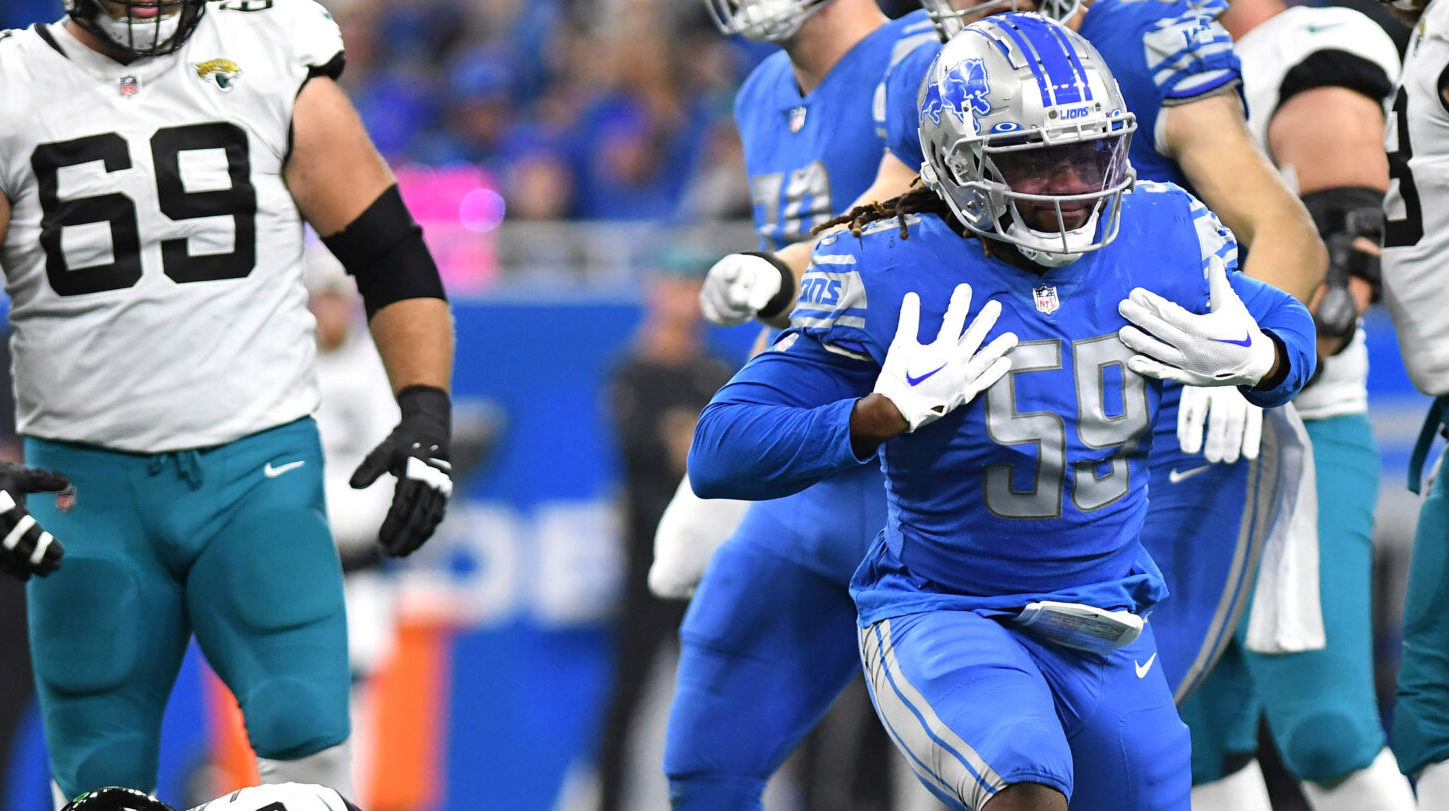
 Detroit Lions
Detroit Lions
Edge James Houston
No. 2 overall pick Aidan Hutchinson had a fantastic 2022 rookie season. He is long, twitchy, quick-handed and mechanically sharp. He makes plays against the run and pass. In long-yardage situations, he can align outside or inside. His three interceptions also hint at some of that T.J. Watt-ish playmaking magic.
But there were almost certainly offensive line coaches late last year who privately thought Hutchinson was Detroit’s second most fearsome edge rusher – at least in obvious pass situations. Sixth-round rookie James Houston (Jackson State) did not even get elevated from the practice squad until Thanksgiving, but starting with his nationally televised two-sack debut (on five snaps) against Buffalo, he was who flashed the brightest on film. He recorded six more sacks during the next five weeks.
Houston has the two most important traits for an NFL edge rusher: explosiveness and bendability. He has teased an ability to build a repertoire of moves off the explosive bend. His spin move to beat Panthers left tackle Ikem Ekwonu was a great example.
Hutchinson might be the Detroit Lions’ best all-around defensive player. But Houston is the most threatening. Together, they’re potentially the league’s best young pass-rushing tandem.
 Green Bay Packers
Green Bay Packers
QB Jordan Love
Yes, it’s true: the quarterback position is much too important to ever be considered an X-factor. But we’re making an exception here because a question needs to be raised: If Jordan Love succeeds right out of the gate like Aaron Rodgers in 2008, what’s keeping the Green Bay Packers out of Super Bowl contention?
Aside from quarterback, the Packers are bringing back mostly the same roster they’ve had the previous four years under coach Matt LaFleur. Yes, that roster went a disappointing 8-9 last season. But it was disappointing because it had won 13 games each of the previous three seasons. The offensive line and backfield personnel remain largely the same, as do all three levels of the defense. Incredibly, this is still one of the league’s youngest rosters.
The NFC has never been weaker. The NFC's best quarterback – whoever you think it is: Jalen Hurts? Matthew Stafford? Dak Prescott? – would be, at best, the sixth-best quarterback in the AFC, and maybe even the eighth or ninth, depending on what happens with Trevor Lawrence, Watson and Lamar Jackson. Aside from Philadelphia and San Francisco (and maybe – maybe – Dallas), the NFC right now has no clear powerhouse teams.
With all this in mind, consider how icky and toxic the relationship between Rodgers and Packers' leadership must have become for this divorce to still happen. Instead of reconciling for one more year, the disgruntled quarterback and frustrated team brass chose to take a much harder 2023 path to the Super Bowl.
Regarding Love, yes it is an enormous – and probably even unfair – “if” that he’ll flourish right away like Rodgers did. And yes, Love has a callow, almost totally new receiving corps, which represents a second enormous “if.” But those two “ifs” work hand-in-hand, and they’re aided by a smart coaching staff, viable ground game and a defense that, though often criticized, is more talented and better-directed than people think.
 Houston Texans
Houston Texans
First-Round Rookies
Are a No. 2-overall drafted quarterback and a No. 3-overall drafted edge defender inherently too prominent to quality as X-factors? Yes, probably. But here’s the point: if C.J. Stroud and Will Anderson hit home runs – or even doubles – the Houston Texans have a chance to be the dark horse winners of the AFC South.
No defensive coach has been better the last couple of years than DeMeco Ryans. Not only were his 49ers the fastest and most fundamentally sound defense in football, but Ryans showed a preternatural knack for successfully taking aggressive, unpredictable gambles in critical moments. To continue the baseball metaphor, Ryans throws the best changeup in the NFL. By far.
Houston’s defense will be as well-coached as any, regardless if it’s Ryans himself making the calls or defensive coordinator Matt Burke. The players receiving that coaching fit the system. Maliek Collins and Sheldon Rankins are a formidable defensive tackle duo. There is speed across the board at linebacker, headlined by Christian Kirksey who, like Ryans’ former stud linebacker Fred Warner, also has stellar zone coverage awareness. This is not to say Kirksey is in Warner’s class; Warner is in a class of his own. But it is to say Ryans can make mostly the same calls with Kirksey he made with Warner.
On the back end, it’s a veteran cornerback group with a potential traveling No. 1 or star left cornerback in last year’s third overall pick Derek Stingley Jr. At safety is versatile, trusted ex-49er Jimmie Ward and looming star Jalen Pitre, a 2022 second-round missile who, with more consistent tackling, can break out similar to how First-Team All-Pro Talanoa Hufanga did in San Francisco.
Offensively, there are better-receiving corps than Robert Woods, John Metchie, Tank Dell and Nico Collins. But with wideouts in new coordinator Bobby Slowik’s presumably Mike Shanahan-style scheme, “good enough” can be good enough given how much of the passing game is predicated on rules and timing. The Texans won’t be totally dependent on receivers making 1-on-1 plays.
Up front, the offensive line is young but athletic. Physically, it fits the wide-zone blocking that will presumably be the rushing attack’s starting point. Having been in San Francisco, Slowik is familiar with the full gauntlet of creative NFL run concepts, including how to buttress them with presnap motion. If the O-line can learn that, the Texans have an ideal runner behind it in second-year stud Dameon Pierce, who is outstanding at setting up blocks.
While Houston’s offensive pieces might fit, there’s no guarantee they’ll snap perfectly in place. For any chance of that, Stroud must come along quickly.
As for the possibly sneakily talented defense? The one missing component is a top-shelf edge rusher. Soon-to-be 35-year-old Jerry Hughes, incredibly, can still win with quickness. Smaller names Jacob Martin and Jonathan Greenard are better than one might think. Ryans did not inherit anything close to a Nick Bosa 2.0, which is why the Houston Texans traded a boatload (the biggest, nicest boat imaginable – probably too much boat, if we’re being honest) in hopes Anderson can be that.
 Indianapolis Colts
Indianapolis Colts
LG Quenton Nelson
Aside from rookie quarterback Anthony Richardson’s development, the biggest factor in Indianapolis’s rebuilding process will hinge on whatever the Colts do best. Because that’s what got new coach Shane Steichen this job: his expansive ability on emphasizing what his players do best.
With the Los Angeles Chargers, that meant an intricate deep-intermediate passing game to capitalize on big-bodied receivers and a field general quarterback (Philip Rivers). Steichen successfully reinstituted those concepts as Philadelphia’s offensive coordinator, but where his offense really thrived was in the way he built a rushing attack around Jalen Hurts and Philadelphia’s second-to-none offensive line.
Steichen will be implementing many similar run packages for Richardson. Indianapolis’s offensive line is nowhere near as talented as Philadelphia’s, except perhaps at the top. Just like how Jason Kelce is the game’s best center, and Lane Johnson’s the best right tackle, Quenton Nelson is the game’s best left guard. Or, potentially, anyway.
Nelson, while still terrific, has not been the relentlessly dominant force the last two seasons that he was out of the gates in 2018-20. If he recaptures that, his mobility and adroitness in space can be deployed as a weapon in Indy’s ground game. Perhaps the only other offensive linemen you could say are “weapons” are Kelce, maybe Johnson and San Francisco’s Trent Williams. Indy can build a run game and screen game around Nelson.
Obviously, Richardson and the Indianapolis Colts will need more than just a superstar left guard to get to where they want to go. But that superstar left guard is tied to the best first steps this team can take.
 Jacksonville Jaguars
Jacksonville Jaguars
TE Evan Engram
No team had more snaps out of 1x3 formations last season than Jacksonville (nine per game). In a 1x3, the tight end aligns by himself on the weak side (usually detached from the formation) and three wide receivers align on the passing strength side. The formation almost always compels a defense to reveal presnap whether it’s in zone or man coverage. A cornerback aligned opposite that iso-tight end = zone, a linebacker or safety = man.
You don’t need a dynamic receiving tight end to do this, though the teams that have one can really benefit. One could argue Travis Kelce has built his Hall of Fame career headlining this formation in Kansas City. The Jacksonville Jaguars can feel extra comfortable with the 1x3 formation because they have an uber-athletic receiving threat in Evan Engram.
The former Giant will not draw double-teams as a Y-iso the way Kelce does, but he can win 1 on 1 outside (128 of Engram’s 766 receiving yards last season came here). This can make defenses pause before dedicating the lion’s share of their coverage to the three-receiver side.
Besides undressing the defense presnap, that three-receiver side and the matchup problems it creates are what make 1x3 formations potent. Zone defense will get stuck with a linebacker or safety on the innermost receiver. Man defense will have a corner playing in the unfamiliar near-middle of the field. These sorts of matchup aids are important when you have good-but-not-special Z and F-type receivers like Zay Jones and Christian Kirk playing opposite Calvin Ridley.
Engram’s 2023 campaign will be interesting. Last year, he wrote a terrific first chapter of a new career narrative after a disappointing tenure with the Giants. But the Jaguars still opted to give him a “prove it” deal via the franchise tag and used a second-round pick on tight end Brenton Strange.
If Engram matches last season’s output, he’ll earn a lucrative multiyear deal, if not in Jacksonville then somewhere else. If he doesn’t match last season’s output, he’ll lose snaps to Strange in the winter and get mid-level money in spring.
 Kansas City Chiefs
Kansas City Chiefs
LT Donovan Smith
When you lead the league in scoring and yardage and win the Super Bowl, the next season essentially centers around “not getting worse." Assuming that recent first-round drafted defensive ends George Karlaftis and Felix Anudike-Uzomah can pick up some of the edge rushing slack after the departure of Frank Clark, the only spot on either side of the ball that faces a potential drop-off from 2022 is left tackle.
The Chiefs took a calculated gamble by signing ex-Jaguar Jawaan Taylor for $20 million a year to play right tackle instead of re-signing Orlando Brown at left tackle. Kansas City would not have won the Super Bowl without its offensive line’s stellar playoff performance. That line was a big reason why the Kansas City Chiefs could navigate Patrick Mahomes’ leg injury.
Albeit with the help of a slippery field, it eliminated Philadelphia’s all-time great pass rush and moved the line of scrimmage in a surprisingly run-heavy second half of the down-to-the-wire Super Bowl win.
Besides struggling to anchor at times as a pass-blocker, Brown had no major weaknesses as Mahomes’ blindside protector. His athleticism stood out in the run game and, notably, the screen game – something Andy Reid has always featured heavily. Taylor, on the other hand, is less dynamic but steadier. He’s one of those stalwart blockers you often fail to notice on film. In the pass-heavy NFL, that’s a compliment.
Reid realizes the difference in value between your left and right tackle is essentially null. That’s why Reid for years had one of the game’s highest-paid right tackles in Mitchell Schwartz, and it’s why he’s willing to spend for the AFC’s highest-paid right tackle in Taylor. The proliferation of shotgun formations has diminished the “blind” side effect.
Most defenses align their best edge rusher opposite the right tackle. This season Taylor is slated to face Hutchinson (Lions), Clark (Broncos), Joey Bosa (Chargers) twice, Jaelan Phillips (Dolphins), Haason Reddick (Eagles), Maxx Crosby (Raiders) twice, Von Miller (Bills) and Matthew Judon (Patriots).
No matter which tackle you think is better, it’s hard to criticize the Chiefs for selecting Taylor over Brown. They had their reasons. Yes, Mahomes, with his seemingly-frenetic-but-actually-lethal movement tendencies, can hide some pass protection woes. That said: You still don’t want to expose the league MVP to hits.
Donovan Smith was available to sign because the team that knew him best (Tampa Bay) no longer wanted him. And presumably neither did 30 other teams given Smith’s deal wasn’t signed until May and, minus incentives, is worth just $3 million.
Smith plagued Tampa Bay’s offense last season with inconsistent pass-pro mechanics and far more mental mistakes than a 30-year-old veteran should make. He was rarely asked to run/screen block dynamically in space, and when he was, he looked sluggish. Simply put, replacing Brown and Andrew Wylie (now in Washington) with Taylor and Smith represents an overall downgrade for Kansas City.
 Las Vegas Raiders
Las Vegas Raiders
Edges Chandler Jones and Tyree Wilson
Chandler Jones is 33 and coming off a 4.5-sack season that was even quieter on film than on paper. Cutting him would have carried $25 million in dead money, so the Raiders drafted his eventual replacement, Tyree Wilson, seventh overall. They will trumpet their edge rusher rotation in 2023, with Wilson likely also getting nickel/dime snaps inside. Even though they have Second-Team All-Pro defensive end Crosby, the Las Vegas Raiders desperately need either Jones to bounce back and/or Wilson to mature quickly.
Las Vegas has by far the NFL’s least-talented cornerback group: Duke Shelley, David Long, Nate Hobbs, Brandon Facyson, Amik Robertson, Tyler Hall and fourth-round rookie Jakorian Bennett. Patrick Graham’s history – and any football observer’s common sense – suggests this defense will live in two-deep zone coverage in 2023.
Graham is one of the most creative coverage disguisers in the NFL, especially in his Cover 2 variations. With rangy safeties like Tre'von Moehrig and vastly underrated ex-Eagle Marcus Epps, plus a stalking linebacker like Divine Deablo, he can afford to be aggressive with his coverage rotations.
But even those will only work consistently if Las Vegas’ pass rush can impact quarterbacks while the rotations are still unfolding. With not much juice outside of Wilson up front inside, and with corners you can’t trust enough 1 on 1 to blitz, Graham is utterly dependent on his edge rushers.
 Los Angeles Chargers
Los Angeles Chargers
RT Trey Pipkins
Think of Trey Pipkins as the representative for the Los Angeles Chargers' offensive line. Much rides on that group because new offensive coordinator Kellen Moore was brought in to craft more deep-intermediate throwing opportunities for Justin Herbert. For those, a quarterback needs time to throw.
One reason Herbert is already an elite quarterback, despite making throws most quarterbacks can't, is he already has a 10-year veteran’s-like sense of knowing when to check the ball down. In fact, it’s something Herbert takes pride in.
Herbert has not played in a poorly designed offense; the Chargers would not have ranked fifth and 13th in scoring the last two years if he did. But he has played in an offense that presented too many checkdown opportunities. Some of that was simply the nature of previous offensive coordinator Joe Lombardi’s Saints-style scheme. The Saints were among the league leaders in running back receiving basically every year under Payton. Don’t be surprised if Denver’s running back receiving numbers go up this year.
By no coincidence, Moore’s forte is crafting deep-intermediate route combinations, with in-breakers for outside receivers and deep crossers/over routes for interior receivers. It’s the perfect approach for a big strong pocket passer like Herbert and for a plus-sized receiving corps like L.A.’s. Keenan Allen, Mike Williams, Quentin Johnston and Josh Palmer are all from 6-foot-1 to 6-foot-4 and from 210 to 220 pounds.
The challenge with those deep-intermediate route combinations is they put a lot of stress on pass-blockers. Moore mostly had great blockers in Dallas. In L.A., he has a largely talented young group, though your pass protection is often only as good as its weakest link. Hence the focus on Pipkins is slow to see and react sometimes.
 Los Angeles Rams
Los Angeles Rams
WR Van Jefferson
With a near-total rebuild going on defensively, the Los Angeles Rams will need their offense to regain at least most of its 2021 form if they want to contend for the playoffs. Besides a healthy offensive line, what the Rams had in 2021 that they never found in 2022 was a viable No. 2 receiver to complement Cooper Kupp.
Allen Robinson came in as a near-prototypical X-receiver but did not click in the timing and rhythm passing game the way Odell Beckham Jr. had. Robinson was not suited to consistently handle the underneath and intermediate Z-receiver duties Robert Woods had mastered.
When Woods tore his ACL midway through 2021, then-second-year wideout Van Jefferson assumed more Z snaps after having worked predominantly at X. Jefferson is now in the final year of his rookie deal, and the Rams will likely call upon him to switch back and forth between both X and Z. With the size to play outside and loose enough hips to smoothly execute underneath/intermediate breaks inside, Jefferson can answer that call. He needs to.
Third-year receiver Ben Skowronek is a grinding overachiever but not quite a full-fledged No. 2. Speedster Tutu Atwell has been a two-trick pony (Go routes and gadget(ish) plays). Newly acquired veteran Demarcus Robinson is essentially a career-long No. 4. The same is likely expected for rookie Puka Nacua, considering he wasn’t drafted until the fifth round.
 Miami Dolphins
Miami Dolphins
DL Christian Wilkins, Zach Sieler and Jaelan Phillips
We might be looking at the first-, second- and third-most underappreciated defensive linemen in football. The fact that they all play together is why the Miami Dolphins enter 2023 with a potential top-five defense. New coordinator Vic Fangio is revered for his blurry, innovative quarters-shell coverage rotations, but those only matter if the defense can first win up front.
The highest-paid true space-eating style defensive tackle is now New York’s Dexter Lawrence ($22.5 million annually). Christian Wilkins is in that Lawrence class. He has less raw power than Lawrence but more athletic flexibility. Against the run, Wilkins not only clogs gaps but also sheds blocks to make stops, both play side and backside. As a pass rusher, Wilkins consistently pushes the pocket and is nimble enough to execute stunts.
Zach Sieler is a premier anchoring defensive tackle but do not think that means he can’t win with movement. His initial quickness, including laterally, can surprise. His 38 run stops were second-most among interior defensive linemen, behind only Wilkins.
Jaelan Phillips is long and flexible. He was drafted in the first round in 2021 and can certainly win there. With Melvin Ingram gone, Phillips may get more edge reps opposite Bradley Chubb. But where Phillips is exceptional is as a passing down three-technique, including in five-down fronts. It will be interesting to see how Fangio uses his most dynamic asset upfront.
 Minnesota Vikings
Minnesota Vikings
G Ezra Cleveland and Ed Ingram
The Minnesota Vikings won 13 games and finished seventh in scoring and yards in 2022. All season long, their film showed the type of consistent, pinpointed weakness that can torpedo a season in crunch time. And that’s exactly what happened.
Despite having invested a 2020 second-round pick in left guard Ezra Cleveland and a 2022 second-rounder in right guard Ed Ingram, Minnesota constantly had to overcome deficient guard play. As luck would have it, in the Wild Card Round, they faced a Giants defense that was uniquely formidable inside with stalwart Leonard Williams and Lawrence.
Advantaged up front, Giants defensive coordinator Wink Martindale, the most aggressive blitzer in the NFL, threw a curveball and took a more coverage-oriented approach, which the Giants did via uncommon split safety and zone looks, especially in the first half.
While Cleveland and Ingram both have the mobility to perform better in Minnesota’s wide-zone rushing attack, the bigger concern is their vulnerability in pass protection. Physical and even mental mistakes have been far too common with both players, which is why Minnesota gave up an NFL-worst 6+ quarterback hits per game – by far the most in the league (ahead of Denver) and nearly double the league average.
Many of these were big hits. Kirk Cousins, for all his mild ups and downs, has always been one of the more courageous quarterbacks in the pocket. But if the Vikings are to get better in 2023, Cousins must require that courage far less often.
 New England Patriots
New England Patriots
WR JuJu Smith-Schuster
Last season, New England’s inconsistent, 20th-ranked net-yardage passing game was overly reliant on screens and vertical routes outside. There was no steady short-intermediate receiving threat. New England’s success rate on 6-12-yard throws to wide receivers and tight ends was 59 percent, fifth best in the league, but they averaged just six such throws per game, which was less than all but six teams.
Adding JuJu Smith-Schuster means more opportunities to sustain offense with underneath completions. The former Steeler/Chief is tailormade to move the chains via crossing routes and tough RAC. This is why the New England Patriots paid extra to obtain Smith-Schuster instead of re-signing their own ascending wideout, Jakobi Meyers.
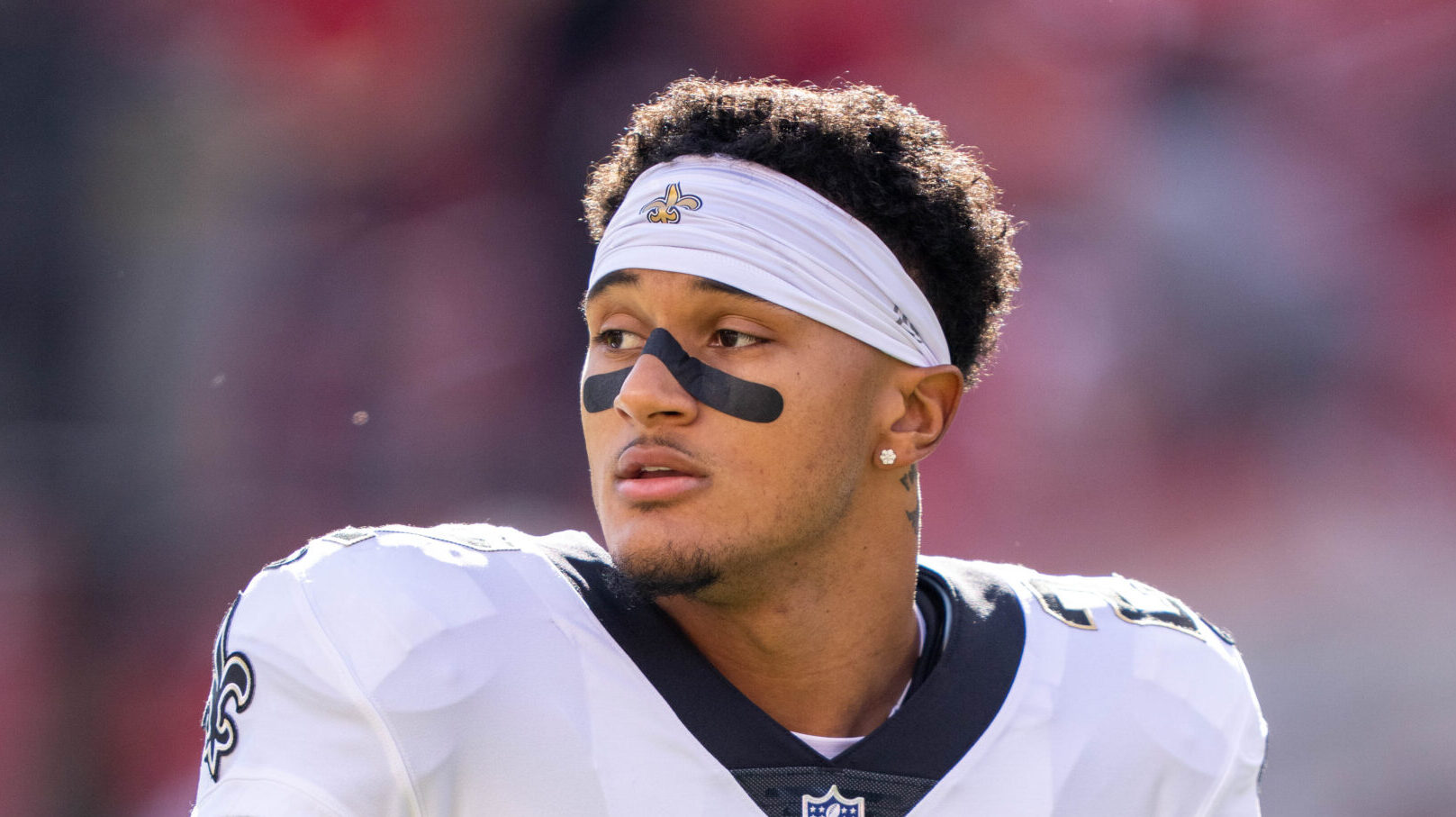
 New Orleans Saints
New Orleans Saints
CB Alontae Taylor
A silver lining to superstar corner Marshon Lattimore missing Weeks 6-16 with a kidney injury last season was it forced second-round rookie Alontae Taylor into a bigger role. And he was quietly spectacular.
Taylor is listed at 6-foot, 195 pounds, and plays bigger than that. Yet, in Week 7, he had positive snaps matching up to shifty Cardinals receiver Rondale Moore. When Taylor faced receivers who were closer (or beyond) his own size, he thrived even more. He was competitive against Davante Adams in Week 8. He was downright dominant against Atlanta’s Drake London in Week 15. Taylor has shown he can make individual pass stops at all three levels downfield.
New Orleans Saints coach Dennis Allen prefers to diversify coverage and keep seven defenders back. The Saints in pass situations have ranked 25th, 24th and 25th in blitz frequency during the last three seasons. But if rookies Bryan Bresee and Isaiah Foskey are slow to develop, Allen might not have enough juice upfront to rely so heavily on a four-man rush.
His 3-2 dime packages are already conducive to amoeba fronts and feature a superb off-the-ball pass rusher in linebacker Demario Davis, plus a historically electric blitzer in safety/slot Tyrann Mathieu. Allen might be inclined to get more creative and aggressive with those dime pass rushes in 2023. For this, it makes a world of difference if Taylor becomes a top-flight cover corner opposite Lattimore.
 New York Giants
New York Giants
TE Darren Waller
Darren Waller missed six games in 2021 and eight games in 2022. So, the Raiders, understandably, traded the soon-to-be 31-year-old tight end to the New York Giants for a third-round draft pick. If Waller regains the fluidity that made him a top-5 tight end in 2019-20, this will be highlighted for its lopsidedness – like Randy Moss to New England for a fourth-round pick or Trent Williams to San Francisco for a fifth and future third.
A resurrected Waller would not just mean a No. 1 receiving option for a Giants offense lacking anything close to an actual No. 1 wideout. It also means a new dynamic, flexible piece to pair with incumbent dynamic, flexible piece Saquon Barkley. The franchise-tagged sixth-year pro is one of the few running backs who can be a veritable threat from anywhere in the formation.
But guys like that, in some ways, are only super valuable if there is a similar weapon to go alongside them. (Best example: Christian McCaffrey and Deebo Samuel in San Francisco.) Otherwise, the implications of their positional flexibility can only go so far. Waller potentially makes Barkley more dangerous.
 New York Jets
New York Jets
CB D.J. Reed
Second-year stud Sauce Gardner may be better than every corner not named Surtain. Last season, Gardner allowed an NFL-best 42.4 passer rating when targeted in man coverage. Only nine of his 27 targets were completions. In quarters coverage, which New York played a league-high 26 percent of the time, Gardner gave up a passer rating of just 69.1.
With offenses having seen Gardner for a year, and with those offenses knowing exactly where Gardner will be in Robert Saleh’s scheme (left corner), it’s possible they will start avoiding the star corner – something they did not do in 2022 when Gardner and right corner D.J. Reed were both targeted on 15 percent of their coverage snaps.
This doesn’t mean every pass that once targeted Gardner will now target Reed. But Reed, the unheralded 2022 free agent pickup from Seattle, can expect a little more action. By all appearances, he is up to it. Reed’s passer rating allowed in quarters (41.7) was actually much better than Gardner’s. In fact, it was better than every corner except James Bradberry’s (8.3).
Yes, a cornerback’s passer rating stats in quarters coverage must be taken with a grain of salt. The coverage’s various zone-match rules can make it difficult to decipher which receiver is which defender’s responsibility. But Gardner and Reed often wind up playing 1-on-1 in these looks, and the broader point is that on film – and on paper – they were fantastic within the context of New York’s scheme.
This defense was quietly one of the league’s best in 2022. For that to recur in 2023, Reed must continue playing at a high level.
 Philadelphia Eagles
Philadelphia Eagles
WR DeVonta Smith
DeVonta Smith’s talent level goes well beyond traditional “X-factor” status. But we’ll use this opportunity to highlight a key but often overlooked aspect of Philadelphia’s offense: It has two true No. 1 caliber wide receivers in Smith and A.J. Brown. That’s saying something in a league that has less than 15 true No. 1 wide receivers altogether.
It’s vital to the Philadelphia Eagles’ identity. We think of this as a running team. The offense appears to be built around the threat of Hurts’ mobility and the rangy athleticism of the league’s best offensive line. Yes, the Eagles last season ran the ball more than all but two teams.
But look closer: In the second half of games, the Eagles called run plays more often (54 percent) than every team except Atlanta (57 percent). But in the first half, they ran the ball just 35.5 percent of the time – 25th most in the league. Their 64.5 percent first-half pass play rate ranked eighth.
The Eagles build leads by airing it out and protect it by running. They can air it out because they have Brown and Smith. Brown’s 1,496 yards were fourth most in the league. He dominated on slant routes (a staple in Philly’s RPO game) and Go balls, leading the league with 26 and nine catches, respectively. Hurts ranked near the bottom of the league on slant route and go ball proficiency in 2021. In 2022, he ranked near the top.
Most would probably view Brown as Philly’s No. 1 receiver. Hurts would likely agree based on how often he looked for Brown on 1-on-1 deep balls when the design of the play had actually gotten the primary read open elsewhere. Brown’s 45-yard touchdown in the Super Bowl was the best illustration of this. That play was called for Smith, who had burned mismatch linebacker Nick Bolton on a deep crosser.
You can’t argue for Brown as Philly’s top wideout and be wrong. But for discussion sake, here’s the case for Smith, who finished with 1,196 yards. In obvious pass situations, he had more targets, catches and yards than Brown. It’s a smaller sample size, but these are also money situations. Smith, though slight of frame, is every bit elite as a contested-catch guy as Brown – at least downfield and outside the numbers. Because Smith is fluid as a multi-level route runner, some defensive coordinators would see him as more threatening.
Again, no right or wrong in this discussion. But the fact the discussion exists is why Philadelphia’s offense is great. It has receivers who can win 1-on-1 but also within the context of designer route combinations. The Eagles lean on those receivers to build leads, which is critical for featuring their ground game (and vaunted pass rush) down the stretch.
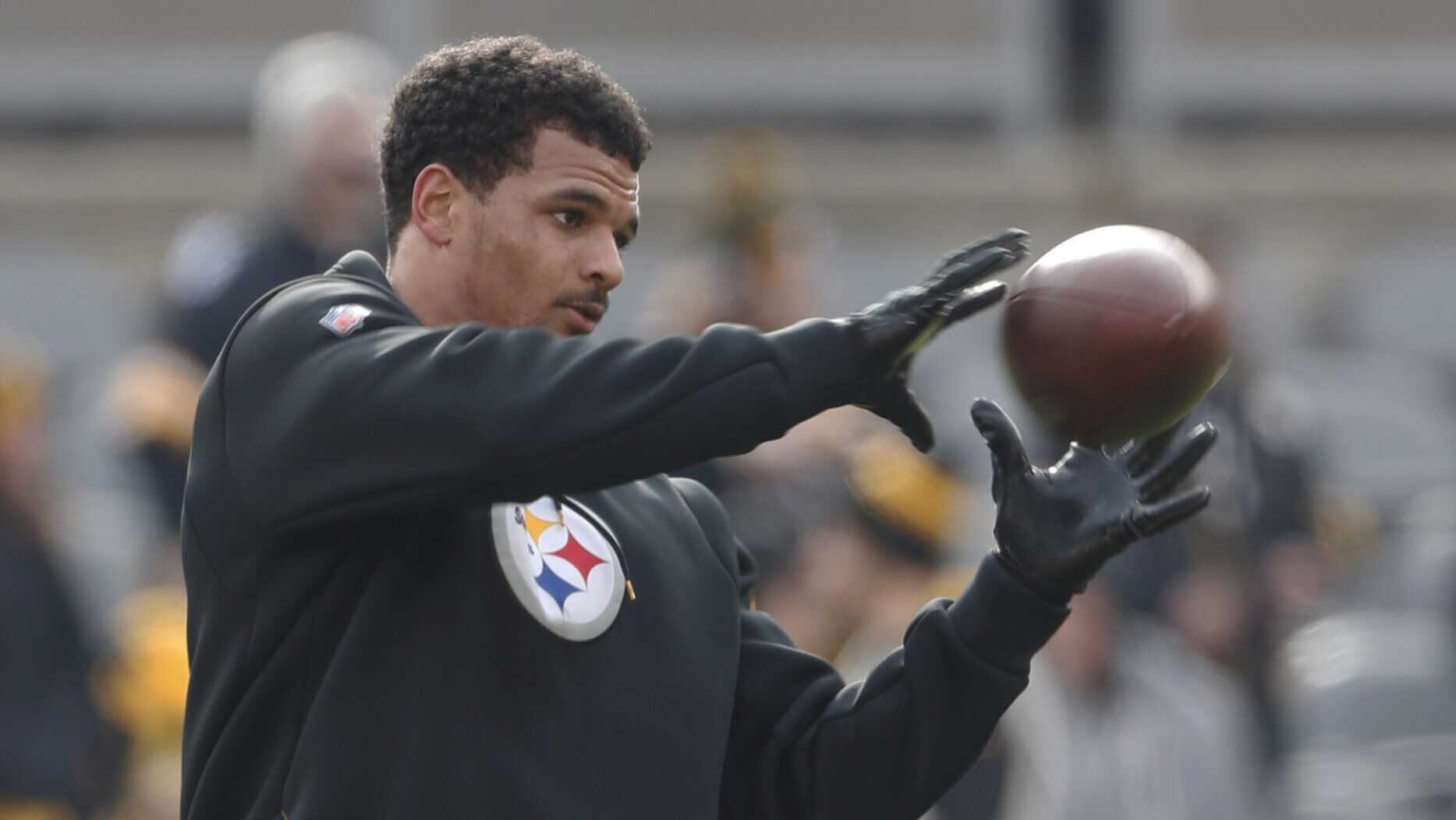
 Pittsburgh Steelers
Pittsburgh Steelers
S Minkah Fitzpatrick
Besides being a premier playmaker in his own right, Minkah Fitzpatrick does all the little things great safeties do that don't show up on paper. For years, the Steelers were a zone-based defense. Under coordinator Keith Butler (2015-21), they evolved into more of a zone-match defense. Under new coordinator Teryl Austin last year, they continued that trajectory, morphing into a predominant man-to-man defense. On third downs, they ranked 10th in man coverage usage and third in Cover 1 success rate allowed (38 percent).
Fitzpatrick was a big reason why. As a deep safety, he has an uncanny sense for nuanced positioning and body angles that lend helpful presence to teammates and cause hesitation in the quarterback. Impressively, in Pittsburgh’s man coverages, Fitzpatrick displays these traits on the move as a rover. They show up when he drops down as the buzz defender in zone coverage.
The Pittsburgh Steelers are hoping that soon-to-be 33-year-old future Hall of Famer Patrick Peterson still has some tread left, 32nd overall pick Joey Porter Jr. can evolve quickly…. and ex-Packer Chandon Sullivan and incumbent veteran Levi Wallace can provide depth. These are mostly bigger, longer-bodied corners, making them more reliant on playing to help coverage.
Sullivan is the wild card of the bunch. He blossomed into a quality slot defender in Green Bay and Minnesota. If he fails to do that in Pittsburgh’s scheme, the Steelers are without an experienced slot corner. Which brings us back to Fitzpatrick. Recall that early in his career, he played all over as a Dolphin, including the slot.
His fellow safeties, Tre Norwood and Damontae Kazee, also have slot experience. The Steelers have options, and they’re free to deploy Fitzpatrick however they deem most valuable, be it maximizing his top strengths (playing safety) or leaning on his ancillary strengths so that other defensive backs can hide their weaknesses (playing slot). As long as Fitzpatrick, arguably the league’s best all-around safety, is available, this question-mark-riddled secondary has a chance to be good.
 San Francisco 49ers
San Francisco 49ers
CB Charvarius Ward
Bosa is the reigning Defensive Player of the Year. Warner is the game’s best all-around stack linebacker and one of history’s best zone coverage defenders. Hufanga is a controlled missile who is coming off an All-Pro season. This is a defense with stars – even superstars – at all three levels. This explains why Charvarius Ward gets overlooked.
The San Francisco 49ers made the former Chief one of football’s 10-highest-paid corners in free agency last year because of his elite combination of size and technique on the outside. Few corners are more impressive against the deep ball – a critical trait in a zone-based 49ers scheme that played Cover 2 on just 13 percent of snaps last year (15th most in the league).
It was either Quarters, Cover 3 or situational man-to-man on nearly 75 percent of snaps, which meant outside corners were exposed to a possible iso-vertical coverage nearly 75 percent of the time. It’s likely to be a similar approach under new defensive coordinator Steve Wilks.
Ward has traveled with certain No. 1 receivers but usually plays left corner – the premium position in a scheme that’s built around facing right-handed quarterbacks. With third-year corner Deommodore Lenoir being perhaps 2022’s most improved defensive player, Wilks does not have to worry about hiding one of his perimeter corners. He’s free to use his overlooked star, Ward, however, he wants.
 Seattle Seahawks
Seattle Seahawks
WR Jaxon Smith-Njigba and RB Zach Charbonnet
After playing with multiple tight ends on a league-high 26 snaps per game last season, the Seahawks clearly want to open up their offense in Year 2 under Geno Smith. Wide receiver Jaxon Smith-Njigba offers the short and intermediate route running to complement deep ball maestro Tyler Lockett and classic big-bodied X-receiver DK Metcalf.
Zach Charbonnet, as The 33rd Team’s Greg Cosell wrote in his predraft scouting report, is suited to play in a mid-zone scheme, which is what offensive coordinator Shane Waldron, with his L.A. Rams roots, wants to feature.
Sometimes – in fact, most times – it’s this simple. A team wants to establish a specific identity – in this case, a modern “11” personnel-driven zone running and play-action heavy offense – so they invest in players who fit that approach.
 Tampa Bay Buccaneers
Tampa Bay Buccaneers
DT Vita Vea
In their 2020 Super Bowl season, the Tampa Bay Buccaneers' defense gave up a league-low 3.0 yards per attempt on called run plays. It got to where offenses wouldn’t even bother trying to run. But in the last two seasons, Tampa Bay's run defense has slipped into mediocrity, allowing 3.9 yards per designed run – right around the low end of the league average.
Defensive tackle Vita Vea is not the reason for this. The sixth-year veteran can win with power early in the down and late in the down. He is mobile, including lateral movement in confined areas and while engaged.
Coincidentally, that vaunted 2020 Bucs run defense played without Vea for much of that season. He fractured his leg in mid-October and did not return until the NFC Championship. But if that defense is to regain its dominance against the run, it starts with one of the league’s most uniquely gifted nose tackles.
Lavonte David and especially Devin White are as fast a linebacking tandem as any. Vea must keep them clean from second-level blockers.
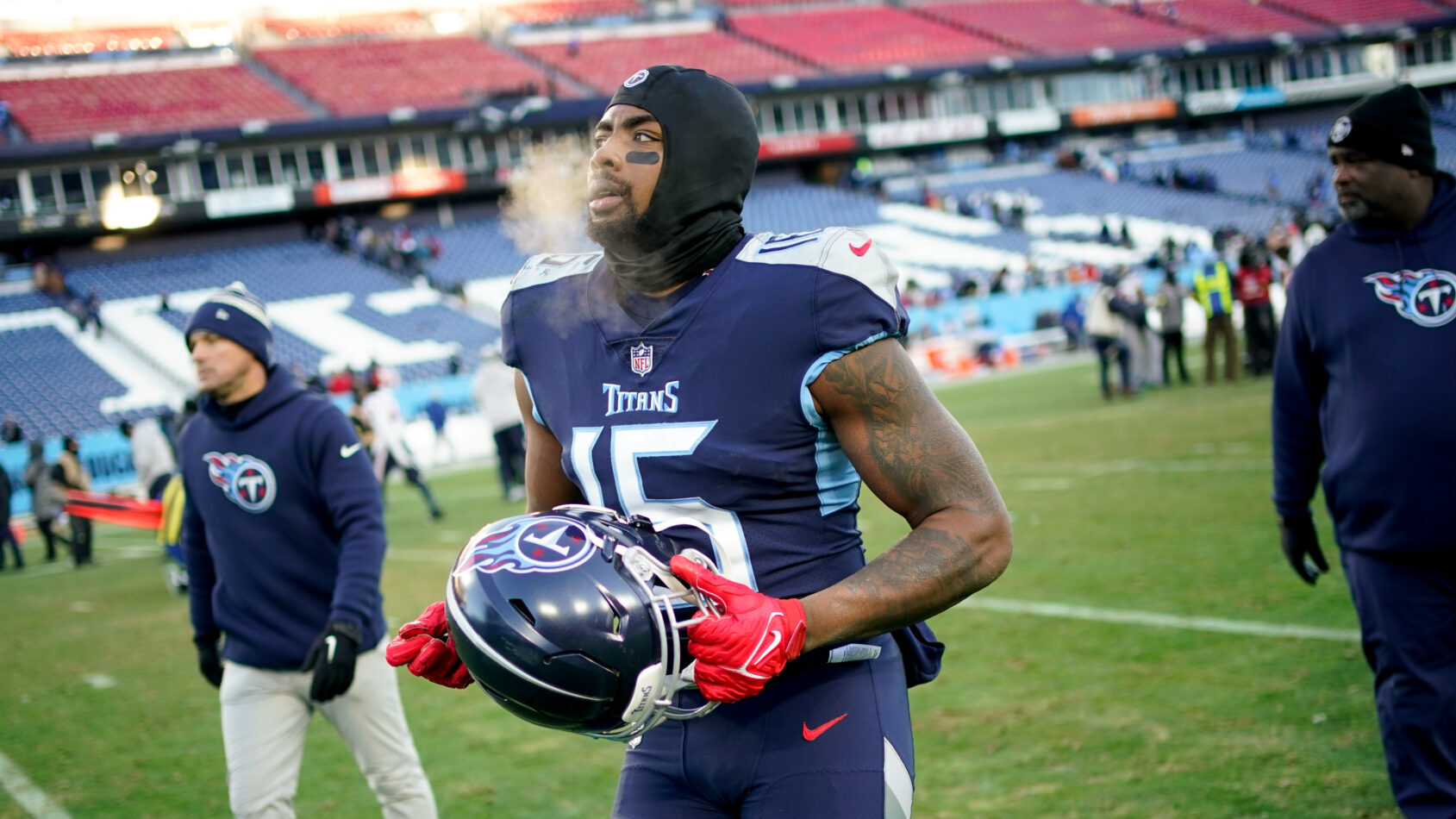
 Tennessee Titans
Tennessee Titans
WR Treylon Burks
The biggest of many problems with the Tennessee Titans’ offense in 2022 was a lack of speed and playmaking at wide receiver. This was especially painful given that, with the ground game too often underwhelming, Tennessee faced third-and-7-10 at a higher rate than every offense except Houston and Denver.
None of these struggles surprised Mike Vrabel and his coaching staff. They knew the Brown trade left them bereft at wide receiver. That’s why they used one of the picks they got for Brown (No. 18 overall) on Treylon Burks. It was a cost-cutting gamble that, through one year, has failed spectacularly.
Brown, now the league’s fourth-highest-paid wide receiver, was a monster for the NFC Champion Eagles. Burks, on the other hand, started just six games, missed another six altogether and finished his rookie year with 33 catches for 444 yards – 29 yards less than what Brown had in December alone.
The good news is Burks has a fresh start in 2023. One thing that new offensive coordinator Tim Kelly did exceptionally well in his play-calling days with the Texans was dial-up vertical route combinations, particularly on early downs where he could attack Cover 3. The Titans offense, which presumably will still run through Derrick Henry, will get plenty of early down Cover 3 looks.
 Washington Commanders
Washington Commanders
RBs Brian Robinson and Antonio Gibson
New assistant head coach Eric Bieniemy is a well-known offensive coordinator but unknown play-caller. He headed up the run game scheme for most of his 10 years in Kansas City, and it reasons that “the run game” will be the starting point for his Washington Commanders offense.
There is no Kelce or Tyreek Hill on the roster, and there certainly is no Mahomes. Whether the starting quarterback winds up being 2022 fifth-round pick Sam Howell or serviceable journeyman Jacoby Brissett, the Commanders will be playing with a quarterback whom they want dropping back, say, 35 times a game, not 50.
With an offensive line that is at best good but not great, the Commanders will be reliant on their ball carriers to generate the occasional big play on their own and, more regularly, turn 4-yard runs into 7-yard runs. It remains to be seen if second-year pro-Brian Robinson and fourth-year pro Antonio Gibson are up to that task.
Robinson has more buildup speed than burst. He can get tough yards inside. The question: Can he create his own space? Or is he just a slightly more dynamic Najee Harris (i.e., stiff and easily replaceable)? Gibson, a 6-foot-2, 220-pound strong finisher, is stylistically similar to Robinson but with a little less power and a little more versatility, especially as a receiver. The Commanders will need these guys to be a productive, high-volume two-headed monster.
Andy Benoit worked for Sean McVay and the Los Angeles Rams coaching staff from 2020 through 2022. Before that, he was a football analyst, writer and content producer for Peter King’s MMQB at Sports Illustrated, as well as at CBS Sports and The New York Times. You can follow him on Twitter @Andy_Benoit

